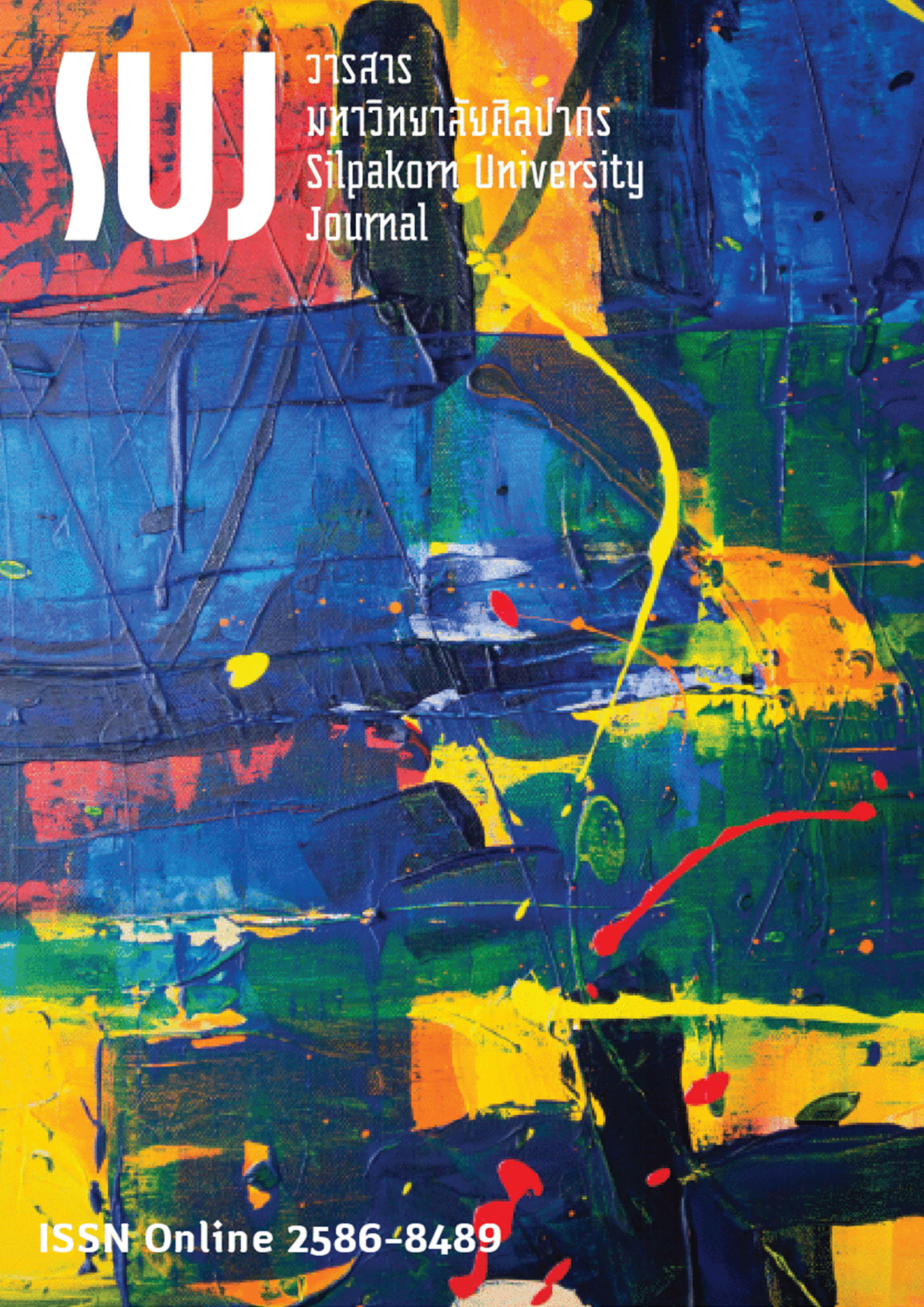ปัจจัยในการคัดเลือกซัพพลายเออร์ในช่วงสถานการณ์โควิด-19 กรณีศึกษา : ร้านขายยาในจังหวัดอุดรธานี (Factors in selecting suppliers during the COVID-19 situation: A case study of Pharmacy in Udon Thani province)
Main Article Content
Abstract
งานวิจัยนี้มีวัตถุประสงค์เพื่อศึกษาปัจจัยในการคัดเลือกซัพพลายเออร์ของธุรกิจร้านขายยาในช่วงสถานการณ์โควิด-19 (ระลอกที่สอง) จากการทบททวนวรรณกรรมที่เกี่ยวข้องได้วิเคราะห์ปัจจัยจำนวน 5 ปัจจัยหลัก ประกอบด้วย ด้านคุณภาพ การจัดส่ง ความสัมพันธ์ สิ่งแวดล้อม และด้านลูกค้า และ 12 ปัจจัยรอง ด้วยกระบวนการลำดับชั้นเชิงวิเคราะห์เพื่อเปรียบเทียบความสำคัญของปัจจัยในการตัดสินใจคัดเลือกซัพพลายเออร์และคำนวณหาค่าน้ำหนักเพื่อจัดลำดับความสำคัญของปัจจัยหลักที่มีอิทธิพลกับเกณฑ์อื่น ๆ โดยวิธีการสัมภาษณ์เชิงลึกในช่วงเวลาดังกล่าวจากผู้เชี่ยวชาญที่มีประสบการณ์การจัดซื้อยามากกว่า 10 ปี ใช้วิธีการเฉลี่ยค่าน้ำหนักเรขาคณิตเพื่อรวบรวมดุลยพินิจของผู้ประเมินทั้งหมดเป็นคะแนนกลุ่ม ผลการวิจัยพบว่า ผู้เชี่ยวชาญให้น้ำหนักมากที่สุดคือด้านคุณภาพ ร้อยละ 54.01% รองลงมา คือ ด้านลูกค้า ความสัมพันธ์ การจัดส่ง และสิ่งแวดล้อม ร้อยละ 16.53, 13.90 , 11.15 และ 4.42 ตามลำดับ ซึ่งรูปแบบการคัดเลือกซัพพลายเออร์ที่ได้จากผลการวิจัย จะช่วยส่งเสริมศักยภาพผู้ประกอบการในการจัดซื้อที่เป็นระบบมากขึ้น ซึ่งสามารถนำไปใช้เป็นแนวทางในการบริหารจัดการเพื่อตัดสินใจคัดเลือกซัพพลายเออร์ธุรกิจยาและธุรกิจอื่น ๆ ที่เกี่ยวข้องอย่างมีประสิทธิภาพ อันนำไปสู่เพิ่มความสามารถทางการแข่งขันของธุรกิจประเภทนี้ให้มีมากขึ้นเพื่อประโยชน์แก่ธุรกิจร้านขายยาในการจัดซื้อยาต่อไป
This research aimed to study the factors in selecting suppliers of pharmacy businesses during the COVID-19 situation (second wave). Based on the literature reviews, the analysis focused on 5 main factors which were quality, delivery, relationships, environment, and customers, and 12 secondary factors. The Analytic Hierarchy Process (AHP) was used to compare the importance of factors in supplier selection and to calculate weights to prioritize key influencing factors. This research also used in-depth interviews during the pandemic with experts who had more than 10 years of experience in drug procurement. The weighted geometric mean method was employed to collect all assessors' discretion as a group score. The results showed that the experts gave the most weight to quality at 54.01%, followed by customers, relationships, delivery, and environment at 16.53%, 13.90%, 11.15%, and 4.42% respectively. The supplier selection models from the research results will help promote entrepreneurs' potential in a more systematic procurement and can be used as a guideline for management to make efficient decisions on the selection of pharmaceutical suppliers and other related businesses. This also leads to increasing the competitiveness of this type of business for the benefit of pharmacy business in drug procurement in the future.
Downloads
Article Details

This work is licensed under a Creative Commons Attribution-NonCommercial-NoDerivatives 4.0 International License.
References
Almasi, M., Khoshfetrat, S., & Galankashi, M. R. (2021). Sustainable supplier selection and order allocation under risk and inflation condition. IEEE Transactions on Engineering Management, 68(3): 823-837.
Aroonudomchai, Sumana, & Pongsathornwiwat, Akkaranan. (2021). Applying multiple criteria decision-making models for co-packer selection problems: A case study of FMCG company (การประยุกต์ใช้ตัวแบบการคัดเลือกแบบหลายเงื่อนไข สำหรับปัญหาการคัดเลือกผู้ให้บริการแพ็คสินค้า กรณีศึกษา บริษัทผู้จัดจำหน่ายสินค้าอุปโภคบริโภคแห่งหนึ่ง). Thai Industrial Engineering Network Journal, 7(1): 42-54.
Arvidsson, A. (P.), & Melander, L. (2020). The multiple levels of trust when selecting suppliers - Insights from an automobile manufacturer. Industrial Marketing Management, 87: 138-149.
Council of Supply Chain Management Professionals (CSCMP). (2013). CSCMP Supply Chain Management Definitions and Glossary. [Online]. Retrieved November 11, 2021 from https://cscmp.org/CSCMP/Educate/SCM_Definitions_and_Glossary_of_Terms.aspx
Eursiriwan, Narin, Panichgarn, Vicrom, Rangsan, Damrong, & Warichwattana, Ubonrat. (2017). The selection criteria of suitable locations for weigh station establishment using the analytical hierarchy process (AHP) (การกำหนดหลักเกณฑ์คัดเลือกตำแหน่งที่เหมาะสมสำหรับการจัดตั้งสถานีตรวจสอบน้ำหนักโดยการใช้ทฤษฎีกระบวนการลำดับชั้นเชิงวิเคราะห์ (AHP)). Kasem Bundit Engineering Journal, 7(1): 17-33.
Food and Drug Administration, Ministry of Public Health. (2021). Statistics of Pharmaceutical Business Licenses 2021 (สถิติใบอนุญาตประกอบธุรกิจเกี่ยวกับยา ประจำปี พ.ศ. 2564). [Online]. Retrieved June 7, 2021 from https://bit.ly/3lQXhcW
Ghorbani, M., & Ramezanian, R. (2020). Integration of carrier selection and supplier selection problem in humanitarian logistics. Computers & Industrial Engineering, 144: 106473.
Govindan, K., Mina, H., Esmaeili, A., & Gholami-Zanjani, S. M. (2020). An integrated hybrid approach for circular supplier selection and closed loop supply chain network design under uncertainty. Journal of Cleaner Production, 242: 118317.
Hafeez, K., & Essmail, E. A. (2007). Evaluating organisation core competences and associated personal competencies using analytical hierarchy process. Management Research News, 30(8): 530-547.
Haji, M., Kerbache, L., & Al-Ansari, T. (2022). Evaluating the performance of a safe insulin supply chain using the AHP-TOPSIS approach. Processes, 10(11): 2203.
Lei, T., Lv, Y., Yajie, Z., & Xiaohua, C. (2021). Logistics service provider selection decision making for healthcare industry based on a novel weighted density-based hierarchical clustering. Advanced Engineering Informatics, 48: 101301.
Li, Y., Diabat, A., & Lu, C.-C. (2020). Leagile supplier selection in Chinese textile industries: A DEMATEL approach. Annals of Operations Research, 287: 303-322.
Mabrouk, N. B. (2020). Interpretive structural modeling of critical factors for buyer-supplier partnerships in supply chain management. Uncertain Supply Chain Management, 8: 613-626.
Phankong, Worapoj, Manisri, Tharinee, & Manisri, Chawalit. (2017). Applicate analytic hierarchy process for evaluation of biomass plant location (การประยุกต์ใช้กระบวนการวิเคราะห์เชิงลำดับชั้นสำหรับการประเมินทำเลที่ตั้งโรงงานผลิตเชื้อเพลิงชีวมวล). Ladkrabang Engineering Journal, 34(2): 37-43.
Qazvini, Z. E., Haji, A., & Mina, H. (2021). A fuzzy solution approach to supplier selection and order allocation in green supply chain considering the location-routing problem. Scientia Iranica, 28(1): 446-464.
Ruenrom, Guntalee, Kometsopha, Ploenthip, & Unahanandh, Sawika, M. L. (2004). Costomer Market Focus: The Power to Differentiate Your Organization (การมุ่งเน้นลูกค้าและตลาด : สร้างองค์กรให้แตกต่างอย่างเหนือชั้น). Bangkok: Thailand Productivity Institute.
Saaty, T. L. (1980). The Analytic Hierarchy Process. New York: McGraw-Hill.
Sabbaghi, M. M., & Allahyari, A. (2020). A supplier selection model emphasizing the project risk management in drug production. Technical Journal, 14(2): 111-120.
Saenchaiyathon, Krittapha. (2021). Strategic Supply Chain Management (กลยุทธ์การจัดการโซ่อุปทาน) (3rd ed.). Khon Kaen: Khon Kaen University Printing House.
Sarasati, B. A., & Dachyar, M. (2021). Green supplier selection using fuzzy approach of AHP and VIKOR - A case study in an Indonesian pharmaceutical company. In Proceedings of the 11th Annual International Conference on Industrial Engineering and Operations Management, (pp. 1527-1537). Singapore: IEOM Society International.
Sathiannoppakao, Watchariporn, & Sirikasemsuk, Kittiwat. (2020). Criteria weight determination for supplier selection using fuzzy analytic hierarchy process: A case study of a frozen chicken distribution in the north-central region of Thailand (การกำหนดค่าน้ำหนักเกณฑ์สำหรับการคัดเลือกซัพพลายเออร์โดยใช้กระบวนการวิเคราะห์ตามลำดับชั้นแบบคลุมเครือ : กรณีศึกษาศูนย์กระจายสินค้าไก่แช่แข็งแห่งหนึ่งในภาคกลางตอนบนของประเทศไทย). Journal of Science Ladkrabang, 29(1): 23-37.
Sirirak, Worapot, Jantakard, Harutairat, Luesak, Peerawat, Jinta-amornchai, Kumphol, Pinchaimoon, Amornrat, Sanguanpang, Somkuan, & Seeta, Chatchai. (2021). The selection and evaluation of supplier: A review and perspective (การคัดเลือกและการประเมินซัพพลายเออร์: การทบทวนและมุมมอง). RMUTL Engineering Journal, 6(1): 38-56.
Srinual, Napat, Nongpa, Adul, Sinrat, Sittichok, Chamsuk, Wawmayura, & Yaklai, Pimsara. (2016). Application of the analytic hierarchy process on warehouse location selection factors (การประยุกต์ใช้กระบวนการลำดับชั้นเชิงวิเคราะห์ปัจจัยในการเลือกทำเลที่ตั้งของคลังสินค้า). Business Review, 8(2): 75-90.
Theeranuphattana, Adisak, & Taesiriphet, Chusri. (2011). Prioritization of supply chain metrics and core processes: An analytic hierarchy process - based model (การจัดลำดับความสำคัญของมาตรวัดและกระบวนการหลักของโซ่อุปทานโดยวิธีแบบจำลองกระบวนการตัดสินใจแบบวิเคราะห์ลำดับชั้น). Chulalongkorn Business Review, 33(1): 1-32.
Tunpaiboon, Narin. (2020). Business/Industry Trends 2020-2022: Pharmaceutical Industry (แนวโน้มธุรกิจ/อุตสาหกรรม ปี 2563-2565: อุตสาหกรรมยา). [Online]. Retrieved August 31, 2021 from https://bit.ly/3oFtYMe
Verdecho, M.-J., Alarcón-Valero, F., Pérez-Perales, D., Alfaro-Saiz, J.-J., & Rodríguez-Rodríguez, R. (2020). A methodology to select suppliers to increase sustainability within supply chains. Central European Journal of Operations Research, 29(1): 1231-1251.


